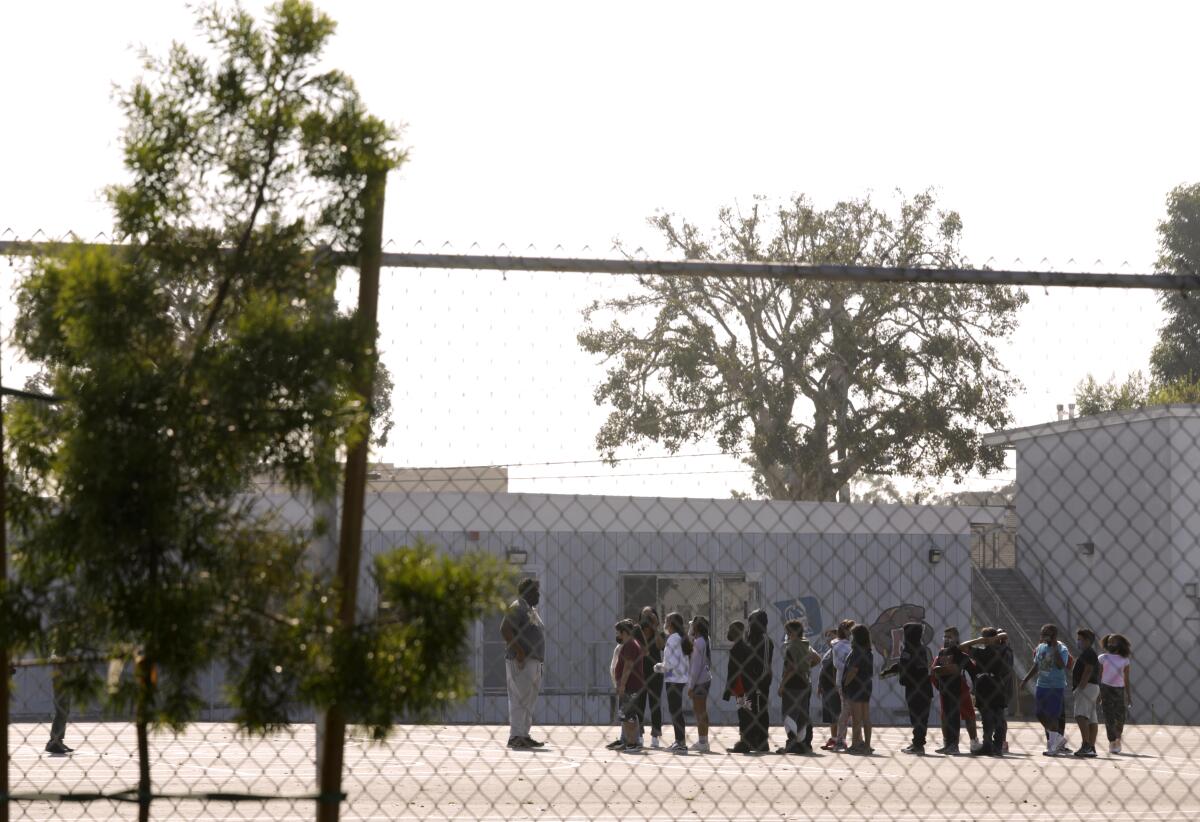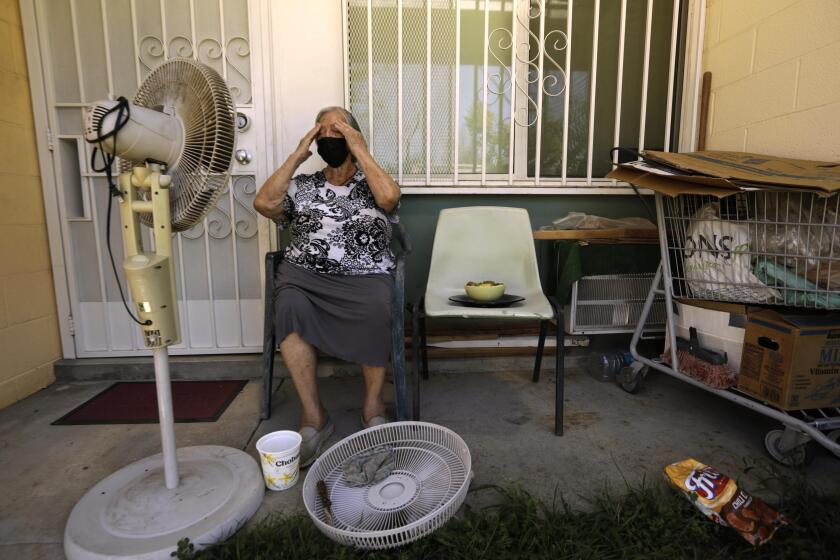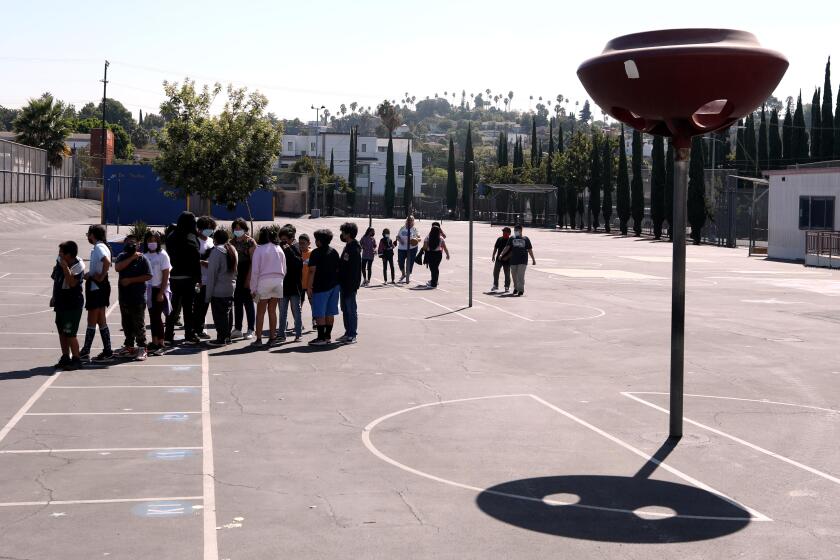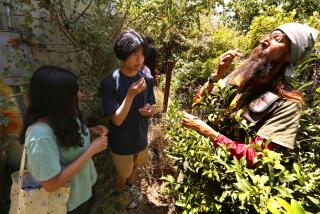Opinion: How California can keep kids cool amid extreme heat

Southern California is experiencing its latest intense heat wave, and the climate-change-fueled cycle of record-breaking temperatures won’t stop anytime soon. Among the most heat-vulnerable Californians: children, who are more susceptible to heat stress and other heat-related illnesses compared to adults.
Though it’s easy to forget during the summer, children spend most of their daytime hours in school, which in many districts start in less than a month. So that’s a natural place to focus on protections against high temperatures, especially since in extreme heat, children miss out on sports and outdoor play and have difficulty learning.
Yet schools are some of the hottest places in our region. Single-story buildings surrounded by open, asphalt-dominated play yards with few trees provide little opportunity for cooling shade. Studying a school in the Pacoima neighborhood in the San Fernando Valley, my colleagues and I found that only 5% of the schoolyard was shaded at noon. A child standing on fully sun-exposed asphalt feels about 54 degrees hotter than a child standing in a shaded area during peak midday heat. And sun-exposed play equipment, asphalt and rubber mats can become hot enough to cause third-degree burns on a 90-degree day.
Parts of Southern California could experience triple-digit temperatures in this heat wave. Here are some tips to beat the heat without air conditioning.
As the climate changes, we can expect more days of extreme heat including during the school year. Researchers estimate that 60% of California’s elementary school districts will experience at least 100 days above 90 degrees annually by 2035 (and predict that some districts, such as Westmorland Union in Imperial County, will experience more than 200). But even in more temperate Northern California, the number of high heat days will increase in the future, extending well beyond summer break and creating dangerous conditions when classes are in session.
Right now, California is missing out on ample opportunities to keep kids cooler — particularly students with the fewest resources. As is the case for many efforts to fight the effects of climate change, failing to consider equity means leaving out the communities that most need support.
Funding for school facilities in California comes mostly from local sources and so varies depending on property wealth, limiting building maintenance and retrofits especially in lower wealth areas. Yet we do not know the full extent of the problem because California does not require all schools to have working air conditioners, track which schools have it or define maximum temperatures for indoor learning and outdoor play. When schools overheat in extreme weather, we can close them — but that doesn’t help children with families who lack cooling systems or can’t afford the energy bills to operate them.
Schools themselves need to be cooler. One promising state program makes available $98.6 million to turn public buildings into community resilience centers for dealing with extreme heat and other effects of climate change. Schools could become such centers by entering joint-use agreements with communities.
More broadly, equity should inform how resilience resources are distributed. Consider California’s Green Schoolyard Grants: At least 70% of the available $117 million is supposed to go to low-income or state-designated disadvantaged communities, which have high economic, health and environmental burdens. The program waives some project costs for these schools but comes with demanding reporting requirements, potentially serving as a barrier for the same low-resource schools that most need support from these grants.
We can affordably and quickly get shade on campuses by updating regulations that were created before climate change made heat emergencies common.
Outdated facility guidelines also need an equity-minded refresh. For instance, the California Department of Education sets requirements for hard-surface areas at schools based on school size, grade level and a definition of “play” that prioritizes asphalt-oriented activities such as basketball and handball. These guidelines were developed to ensure equitable access to play space. But they force school districts with large enrollments and not a lot of land — including many disadvantaged school districts — to pave virtually the entire school site, leaving no room for cooling trees and grass.
Similarly, bond measures that fund facility upgrades at schools do not factor in adaptations. The state could fix that by updating these measures to prioritize heat-preparedness projects in disadvantaged schools, such as new HVAC systems, removing asphalt and installing shade structures. But red tape can make even these common sense interventions far too difficult and expensive. For instance, installing a shade structure may require facility upgrades under California law that cost a lot of money but have questionable benefits for students, even concerning the state’s intended goal of accessibility. (A bill in the California Legislature, SB 515, would exempt certain projects from onerous upgrades.)
There is some promising news. A pilot by the Trust for Public Land’s Living Schoolyard Coalition is greening nearly 30 schools in the Los Angeles Unified School District. And when it repaves schools, LAUSD reduces the total asphalt footprint, which will help lower the temperatures on school grounds.
Several bills introduced in Sacramento also aim to help schools adapt to rising temperatures. One bill (AB 527) would expand and improve upon CalFire grants available for school greening projects; another (AB 384) would create the first audit of school indoor cooling systems and make recommendations for maximum temperature thresholds . A pair of bills (SB 394 and SB 499) would require master plans to make school grounds more climate- and heat-resilient. If these proposals move forward, they should focus on schools in highest-need districts first.
All of California’s nearly 6 million K-12 public school children deserve to learn and play in safe conditions. Even as the climate warms, that’s a goal we can and should achieve.
V. Kelly Turner is an associate professor of Urban Planning and Geography and associate director of the Luskin Center for Innovation in the Luskin School of Public Affairs at UCLA.
More to Read
A cure for the common opinion
Get thought-provoking perspectives with our weekly newsletter.
You may occasionally receive promotional content from the Los Angeles Times.












